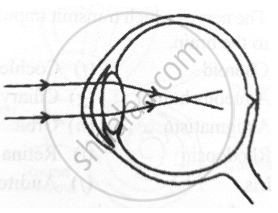Advertisements
Advertisements
Question
Draw a simple diagram of the human eye and label clearly the cornea, iris, pupil, ciliary muscles, eye-lens, retina, optic nerve and blind spot.
Solution

APPEARS IN
RELATED QUESTIONS
What is the name of:
the light-sensitive layer in the eye?
What is the range of vision of a normal human eye?
The descriptions of five kinds of images are given below:
(a) diminished and virtual
(b) enlarged and real
(c) enlarged and erect
(d) real and inverted
(e) virtual and the same size
Which one of these describes the image formed:
(i) on the retina of the eye?
(ii) by a magnifying glass?
(iii) by a convex driving mirror on a car?
(iv) by a plane mirror?
(v) on the screen of a slide projector?
Write whether the following is true or false:
Rods are the receptor cells in the retina of the eye sensitive to dimlight.
Choose the correct answer.
Which one is the photoreceptor _____________
Answer the following question.
Trace the sequence of events Whichoccur when a bright light is focused on your eyes.
Mention, if the following statement is True or False
Cones are the receptor cells in the retina of the eye sensitive to dim light.
Write an Explanation.
Farthest distance of distinct vision
Given below is a diagram depicting a defect of the human eye. Answer the questions that follow:

- Give the scientific term for the defect.
- Mention one possible reason for the defect.
- What type of lens can be used to correct the defect?
Match the following:
| Column - I | Column - II | ||
| 1 | Retina | a | Path way of light |
| 2 | Pupil | b | Far point comes closer |
| 3 | Ciliary muscles | c | near point moves away |
| 4 | Myopia | d | Screen of the eye |
| 5 | Hypermetropoia | e | Power of accomodation |
